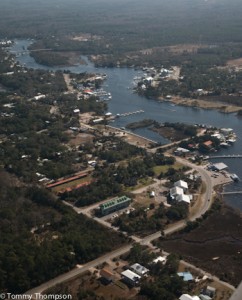Steinhatchee is all about recreational fishing!
Steinhatchee is all about recreational fishing. Just a short drive from US19/98, this one-ramp fishing village sits at the mouth of the Steinhatchee River, which empties into the Gulf of Mexico between Cedar Key and St. Marks. What’s between Cedar Key and St. Marks? Not much—thus the popularity of Steinhatchee to anglers from far and wide. With the exception of recreational scallop season (July 1 to September 10), the inshore and offshore waters here are never very crowded. There are two full-service marinas on the Taylor County side of the river. A third, on the Dixie County (south) side illustrates the fact that the two communities are joined more by geography than by politics. Lodging, restaurants, grocery and convenience stores are found on both sides of the river, and despite the fact that Jena is a Dixie County community, the name ‘Steinhatchee’ seems to cover the entire area. In fact, one of the better public boat ramps is located in Jena, not in Steinhatchee-proper. For inshore anglers, Steinhatchee offers vast expanses of very shallow rocky flats, some extending well into the gulf, as well as numerous rocky creeks within a short distance from the river’s entrance. And while offshore anglers don’t have the luxury of the same short runs as their inshore brethren, similar rocky bottom structure found inshore can also be found in the 40-foot-plus depths to the west. That combination of rocky ‘live’ bottom, warming April weather and the opening of grouper ‘season’ is not to be missed, especially on this part the Big Bend.

The first results of May’s warming weather and water are the new growth of sea grass beds and the reappearance of the bait fish and crustaceans that take cover within. As a result, the flats and creek fronts become active feeding grounds for redfish and trout while the deeper offshore waters begin to stir with activity. Red grouper are again targets for offshore trolling enthusiasts pulling lipped plugs deep over live bottom. You’re likely to find the last of the winter sheepshead crop on the Steinhatchee Reef (N29 39.900 W83 37.590), but this is really the time of year to look there for the season’s first pelagics, king and Spanish mackerel in particular, and cobia. This close-in reef, as well as the Taylor County Reefs (approx. N29 45.660 W83 43.960), attracts early pods of baitfish and with them, predators.
Getting to the grouper from Steinhatchee couldn’t be easier, even for those of you new to the area and without ‘numbers’. I recommend that ‘newbies’ begin their offshore trip by running southwest from Marker #1 until they reach 30-feet and then begin trolling lipped deep-running Mann’s Stretch 30 plugs close to the bottom. On this course, you’ll probably encounter red grouper over flat bottom and if you cross a small rock pile, a gag or two. Should you hit the jackpot and troll up a keeper gag, hit the ‘man overboard’ button on your GPS (or toss a marker) and fish the spot with natural bait or a ‘sweetened’ jig. This is the way new grouper spots are found. Besides, even if it’s not necessarily new and already in someone else’s log book, you’ve found it today and it’s yours to fish. Good public numbers exist and are published (at www.myfwc.com and www.seahag.com, for example), but it’s those anglers willing to search between them who sometimes garner a set of fresh spots to log.
Don’t forget to prepare yourself for the first mackerel and cobia of the new year. Birds wheeling and diving over bait near some of the big offshore sand bars are a sure sign of mackerel in the neighborhood. If you encounter such activity, troll the edges of the bait pod with flashy lures rigged onto steel leaders. Spoons work well, as do jigs ‘sweetened’ with strips of fish belly (I salt and freeze strips of mullet belly for just this purpose.). Cobia, on the other hand, will likely see your boat at anchor and circle, like trained dogs around a camp kitchen—trained to circle, but not necessarily to eat. Hooking them can sometimes be an exercise in futility, but if they’re in an eating mood, a live pinfish or cigar minnow is an excellent choice of bait. Many Big Bend anglers keep a ‘pitch rod’ rigged and ready with a live bait already hooked-up and holding in their live well just in case a cobia appears over an offshore rock pile or along a bar edge. This is the perfect reason to have a 30-pound class spinning outfit on the boat—even while you’re fishing for other species with heavier tackle.
Everyone along the Big Bend is glad May’s here, but none more so than the residents of Steinhatchee and the anglers who frequent the nearby Gulf waters. It’s a good feeling when the sea grass gets green!

